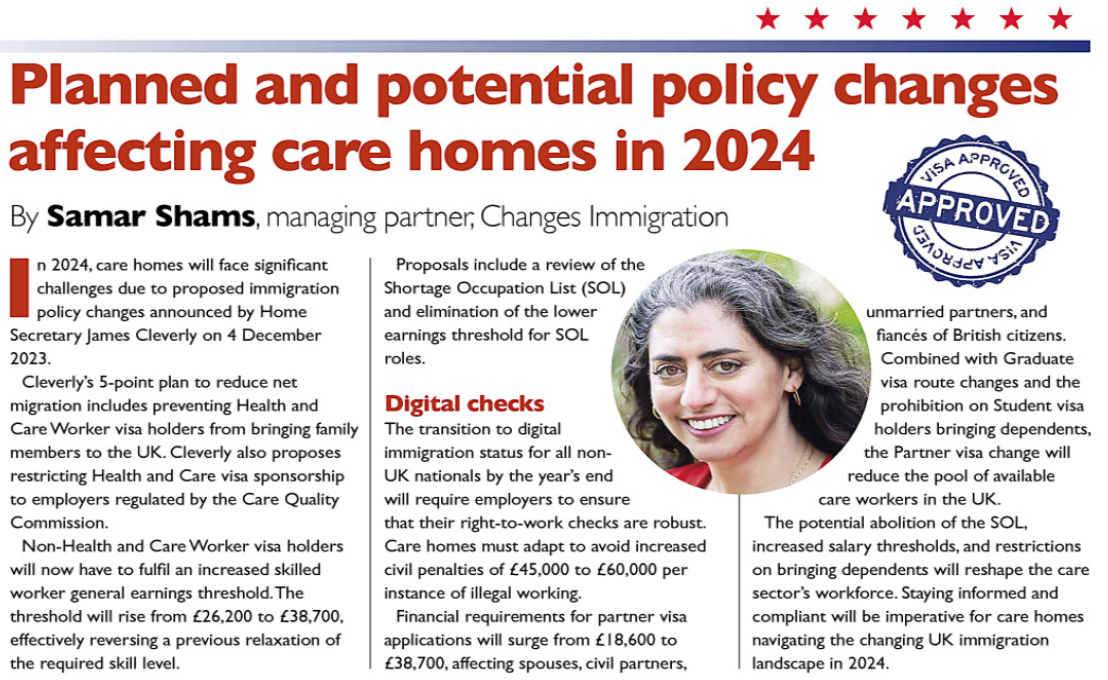On 7 December 2023, the UK government published changes to the Immigration Rules, impacting Visitor Rules and the Youth Mobility Scheme since 31 January 2024. The changes provide more opportunities for visitors and young individuals participating in cultural exchange programs.
The new Immigration Rules follow the Home Secretary’s announcement on 4 December 2023 of a ‘five-point plan’ to reduce net migration. The measures include reforms to the Skilled Worker visa and the Health and Care visa, and changes to family sponsorship requirements. Further rules changes are expected to initiate elements of the ‘five-point plan’ starting in early 2024.
This article evaluates the potential impact on net migration of changes to Visitor and Youth Mobility Scheme visas, which do not form part of the ‘five-point plan’.
Changes to Visitor rules
Modifications to Visitor rules permit wider activities for visitors to the United Kingdom including working remotely for their overseas employer, provided it is not the primary purpose of their visit. This allows short-term business travellers to respond to emails, make calls, and undertake other related work activities. Living in the UK through frequent and successive visits remains prohibited.
New intra-corporate activity permissions allow employees of overseas companies to work directly with UK-based clients linked to the same corporate group as the overseas employer. Employees are allowed to engage in advising, consulting, troubleshooting, training, or knowledge-sharing, provided it is incidental to their employment abroad and not part of a project directly delivered to the UK-based client by the overseas employer.
The category of Permitted Paid Engagements is now integrated into the Standard Visitor category. Speakers at conferences can receive payment from a UK company. Visitors engaging in permitted paid engagements must arrange their activities before travel, declare the permitted paid engagement in their application or upon entry to the UK, and complete the activity within the first 30 days of arrival.
Legal professionals benefit from an expanded list of permitted paid activities. The new rules encompass providing legal advice, drafting contracts, conducting advocacy in court or tribunal, acting as an arbitrator or mediator, attending conferences, and teaching.
Changes to Youth Mobility Scheme
The Home Office has enhanced the Youth Mobility Scheme, designed for cultural exchange programs for young people. The age range for Australians, Canadians, and South Koreans has expanded from 18–30 to include applicants up to 35 years old. Australians and Canadians can extend their visas by up to one year, allowing for a total stay of up to three years. Citizens and nationals of Uruguay and Andorra are now eligible to apply under the Youth Mobility Scheme. The Japanese and South Korean citizens and nationals may apply without needing an invitation as they used to.
Impact on Net Migration
Recent data from the Office for National Statistics reveals that net migration, representing the disparity between arrivals and departures in the UK, surged to 745,000 in the year ending December 2022. The most recent statistics published on 23 November 2023 indicate that approximately 1.18 million individuals arrived in the UK between June 2022 and June 2023, while an estimated 508,000 departed, resulting in a net migration figure of 672,000. The predominant contributors to immigration are non-EU nationals, particularly those arriving for study and work, addressing shortages in the health and social care sectors. The UK’s humanitarian initiatives for Ukraine and Hong Kong nationals have also played a significant role in the high net migration figure (Long-term international migration, provisional – Office for National Statistics (ons.gov.uk)).
Net migration in the UK is calculated by subtracting the number of people permanently emigrating from the total number of individuals immigrating for a duration of at least 12 months. However, conversations about net migration frequently neglect the tendency of a significant portion of migrants to arrive in the UK for relatively short periods before emigrating. Consequently, although net migration may appear exceptionally elevated in the coming years, the anticipation is that emigration will eventually increase as well. This dynamic is expected to result in a decline in net migration, even if the influx of individuals immigrating to the UK remains substantial (Why are the latest net migration figures not a reliable guide to future trends? – Migration Observatory – The Migration Observatory (ox.ac.uk)).
Will visitor rules changes impact reality, data or both?
Expanding the permitted activities for visitors may lead to a reduction in grants of work visas and in net migration figures in turn. Overseas employees will no longer be required to obtain work visas to conduct certain activities on behalf of their employers outside the UK. Visitor visas under the routes affected by the changes are granted for up to 6 months, not meeting the criteria for ‘long-term’ migration. Therefore, the changes to the visitor rules might reduce net migration without changing who is coming to the UK and what they are doing here very much.
However living in the UK through frequent or successive visits remains prohibited for visitors, whereas workers who are sponsored to work in the UK are permitted to live here. It is possible that the change in visitor rules will contribute to a drop in actual migration as overseas employers will choose to send employees to the UK as visitors instead of sponsoring them to live and work in the UK.
It is important to note that business activities permitted to visitors are still strictly defined. Breaching the conditions of one’s permission as a visitor can result in severe consequences for businesses and individuals, including illegal working fines, sponsor licence revocation or ineligibility and UK entry bans.
Overseas companies engaged with or looking to engage UK-based clientele may still need to consider setting up a UK-based entity and obtaining a sponsor licence to support work visas. The new changes do not permit overseas employees to work in the UK on a contract being delivered directly by their overseas employer to a UK client; these employees still require work visas.
The Youth Mobility Scheme – the long and the short of it
Changes to the Youth Mobility Scheme route may directly increase net migration in the short term, but longer-term effects are unlikely to be significant. According to the national statistics report published on 7 December 2023, in the year ending September 2023, 32% of ‘Temporary Worker’ visa grants were under the Youth Mobility Scheme route (Why do people come to the UK? To work – GOV.UK (www.gov.uk)). The report indicates the return to the pre-pandemic levels, having increased by 53%. Even so allocations of Youth Mobility Scheme places totalled only 8,051. The total increase in places allocated to Japanese and South Korean nationals together this year is 10,000, which could nudge immigration figures upwards.
The increased allocations and other changes such as increasing the age threshold, allowing extensions, and simplifying the application process suggest that the government is expanding opportunities for young people from participating countries to explore work and life in the UK. However, as the Youth Mobility Scheme does not lead to settlement, and successful applicants are ineligible from applying to the Scheme again, the only way for Youth Mobility Scheme visa holders to remain in the UK is to switch to another visa category, such as a sponsored work visa or a partner visa. Many successful Youth Mobility Scheme visa applicants in 2024 will contribute to emigration numbers in 2 or 3 years’ time.
Looking ahead
The Government seeks to transform the UK’s immigration landscape to reduce net migration. The effects that changes to the Visitor rules and Youth Mobility Scheme will likely be tepid. At the time of writing, the Immigration Rules to support the five-point plan to reduce net migration have not yet been published. Considering the lag time in publication of immigration statistics, politicians are unlikely to be able to point to solid data on new policies affecting net migration before a General Election. That does not mean that they will not try.
Publication Date: 9 February 2024









